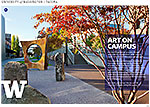Main Content
Parapet Relay
Buster Simpson
1995
Buster Simpson's Parapet Relay (1995) is hard to miss. A massive pair of signs along the south and east rooflines of Garretson Woodruff Pratt give different messages depending on the viewer's angle. A series of cast iron and bronze sidewalk plaques mark the optimum viewpoint for each message. GWP was originally built as a warehouse and signs advertising those services were prominently painted on almost every available surface of the building, including one that read "Storage." This installation pays homage to the history of the building and the neighborhood with language that reflects both the historic and contemporary uses of the space.
When you move downhill along 19th Street (starting at Fawcett), you will first read the word "Idea" (and "Wisdom" when the light is just right), then "Gather", then (after crossing Pacific) "Labor." Walking towards downtown along Pacific Avenue, you first see the word "Storage," then the letters "UW" (in front of the History Museum), and then finally "Tacoma."
Funded by the Washington State Arts Commission’s Art in Public Places Program.
Chinook Red Chandelier
Dale Chihuly
1999
Internationally-renowned glass artist Dale Chihuly — born in Tacoma and a graduate of UW Seattle — presented Chinook Red Chandelier (1999) to the University to celebrate the permanent campus. The piece is 19 feet tall, weighs 1,500 pounds and consists of more than 900 individual pieces that were assembled on site. It is even more striking at night when it is lit up like a glowing beacon.
The Four Elements
Steve Gardner
2003
The Four Elements (2003) is a four-panel terracotta sculpture by artist Steve Gardner. These large carvings hang in the main stairs of the Science Building. Each sculpture depicts a personification of one of the four elements — earth, air, water and fire (in Western thought that is — many Eastern traditions include a fifth element as well). Many of the images and patterns within the sculptures draw on cultural traditions from around the world, a reference to the universality of scientific thought and discovery.
Funded by the Washington State Arts Commission's Art in Public Places.
Brian Goldbloom's granite sculpture, Terminus (2002), references Tacoma's place as the Western terminus of the Northern Pacific Railroad. The sculpture lies in a small courtyard just off the tracks that once served the Northern Pacific railroad. It is constructed of several hinged pieces of rough white granite and one piece carved to look like an open suitcase.
Funded by the Washington State Arts Commission's Art in Public Places.
In 1944, after the liberation of Paris from the Nazis, Pablo Picasso became an active participant in the Peace Movement. In 1949, the Paris World Peace Conference adopted a dove created by Picasso as the official symbol of the various peace movements. Picasso would repeat this image, which he titled Le Visage de la Paix (The Face of Peace), with variations for several occasions. This particular drawing was created in 1953, when Picasso offered it as a gift to Hiroshima, Japan, marking the anniversary of the atom bomb blast that destroyed much of the city. In 2009, a group of peace advocates traveled to Hiroshima to take part in another observance. Tacoma’s Father William J. (Bix) Bichsel was among the leaders of this group.
As is customary on formal occasions in Japan, gifts were exchanged. The group presented a few modest but symbolic gifts to the Japanese hosts. The Japanese, in turn, had a gift for them: Picasso’s Le Visage de la Paix. After returning to Tacoma, the group asked the University to display the drawing so others could see it and learn of its background. The drawing hangs in the Snoqualmie Building, visible from the 2nd floor balcony next to the Reading Room.
Felt pen on fabric. Gift of Journey of Repentance, 2011
Armed with paint and differing points of view, six artists — Pam Keeley, Deborah Lawrence, Linda Davidson, Stevie Webb, Kevin Wildermuth and Ellen Ito — conducted a live experiment in getting along in 2010. The result was bipARTisan. The six artists have very different styles, but they drew common inspiration from “the way our government is so polarized it can’t work together." Their project was a lesson in whether people can work together. The idea was to see what emerges as the artists repeatedly return to the mural, one or two at a time, and paint on the wall. Or re-paint it. Artists could paint over what’s been previously painted; there was no plan for what they ended up with. The resulting mural is in the student study area behind BHS 106.
All over campus are vintage signs, whose faded lettering recall the days when the UW Tacoma campus was a bustling downtown warehouse district. The most obvious signs can be found inside Philip Hall (pictured) and the Dougan Building, and outside Mattress Factory (complete list). A display board showing many examples around Tacoma and giving some history of this once-common commercial art can be found inside the Pacific Avenue entrance to the Joy Building.
Display text by Kristen Kendle. Display donated by Korsmo Construction (2012).
The nine-foot-tall bronze sculpture, Maru (2014), was created by renowned Northwest artist Gerard Tsutakawa in collaboration with Kenichi Nakano, principal of Nakano Associates, landscape architects. The sculpture honors the Japanese Language School that once stood at Tacoma Avenue and 19th Street and the Japanese-American community that thrived in this neighborhood prior to World War II. The complete story is told on plaques next to the sculpture.
The work is set along the Pairie Line Trail, at the north end of the Joy Building, where the former Northern Pacific rail line traverses the campus. The rail line is being converted into a space that features a series of park-like gathering places joined by a landscaped bicycle-and-pedestrian pathway.

